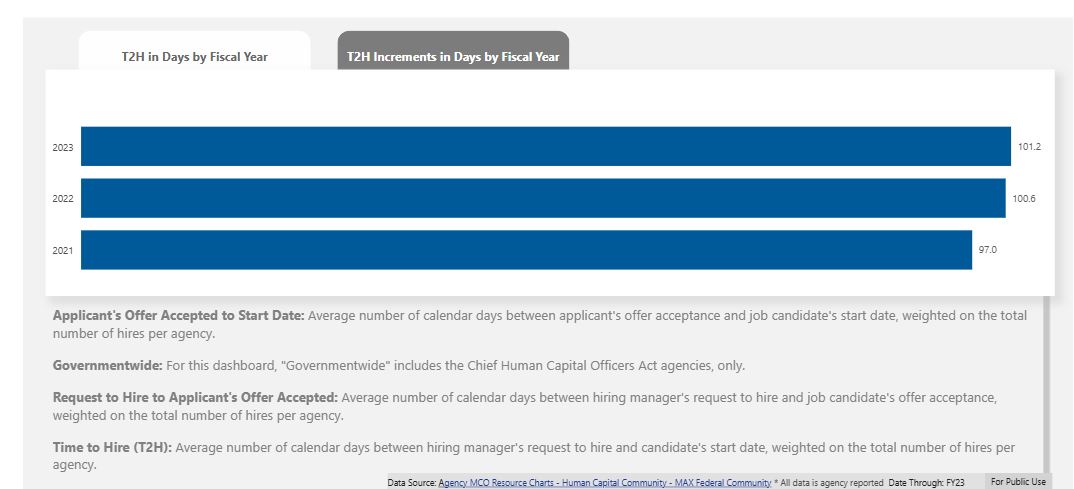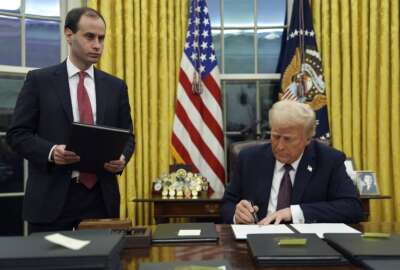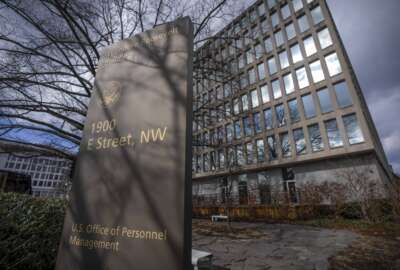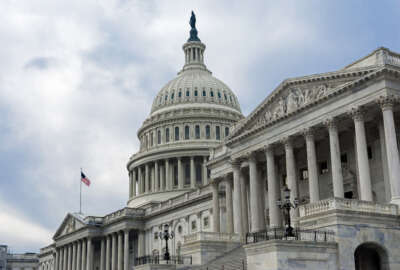Hiring reform, SES accountability to get more scrutiny
Agencies to receive new plans to improve the hiring process and performance plans for SESers in the next 120 days under Trump administration’s new policies.
By late Spring, agencies will get a new plan to improve their hiring process with an ultimate goal of bringing down the time to hire to 80 days.
President Donald Trump’s executive order signed yesterday charges the Assistant to the President for Domestic Policy James Sherk, in consultation with the director of the Office of Management and Budget, the director of the Office of Personnel Management and the administrator of the Department of Government Efficiency (DOGE), in coming up with the plan in 120 days “that brings to the federal workforce only highly skilled Americans dedicated to the furtherance of American ideals, values, and interests.”
Trump detailed nine areas the plan should focus on ranging from fully implementing the Chance to Compete Act, which former President Joe Biden signed into law last month, and the use of modern technology to support the recruitment and selection processes.
A key piece to this order and another one the President issued yesterday is around the Senior Executive Service.
The hiring EO says, “This Federal Hiring Plan shall include specific agency plans to improve the allocation of Senior Executive Service positions in the cabinet agencies, the Environmental Protection Agency, the Office of Management and Budget, the Small Business Administration, the Social Security Administration, the National Science Foundation, the Office of Personnel Management and the General Services Administration, to best facilitate democratic leadership, as required by law, within each agency.”
New SES performance plans coming
At the same time, Trump signed another memo specifically focused on the management of the SES corps.
“Only that chain of responsibility ensures that SES officials are properly accountable to the President and the American people. If career SES officials fail to faithfully fulfill their duties to advance the needs, policies and goals of the United States, the President must be able to rectify the situation and ensure that the entire Executive Branch faithfully executes the law,” Trump wrote in the memo. “For instance, SES officials who engage in unauthorized disclosure of Executive Branch deliberations, violate the constitutional rights of Americans, refuse to implement policy priorities or perform their duties inefficiently or negligently should be held accountable. The President must be able to trust that the Executive Branch will work together in service of the nation. My administration will restore a ‘government of the people, by the people, for the people.’”
Trump called for OMB and OPM to issue new SES performance plans in the next 30 days and all agencies will have to adopt them.
Additionally, Trump called for agencies to “terminate its existing Executive Resources Board (ERB), institute a new or interim ERB, and assign senior noncareer officials to chair and serve on the board as a majority alongside career members,” and “Each agency head should terminate its existing Performance Review Board membership and re-constitute membership with individuals committed to full enforcement of SES performance evaluations that promote and assure an SES of the highest caliber.”
Dan Blair, a former OPM deputy director and now an independent consultant, said both of the orders from the President create more questions than answers.
“This is a full employment plan for lawyers in federal employment law. I think both of these will be heavily litigated as there may be concerns that these violate a cornucopia of current law and first amendment rights. I would expect a number of lawsuits seeking to prevent these order from being implement in next few weeks,” Blair said. “The hiring reform order says candidates have to faithfully serve the Executive Branch. I never remember seeing that. I know federal employees are asked to protect and defend the Constitution, but this seems to put the Executive Branch in a superior position to Congress or the Judiciary. I think it’s just ripe for litigants to say this violates current law or first amendment rights. This is wording I haven’t seen before and when you break ground like this, you are going to alert other groups that there is no precedent or authority for this.”
Reducing time-to-hire long-standing challenge
Beyond the potential for litigation, Blair said a lot of what the orders call for are things that have been tried before over the last 20-plus years.
“I think everyone is frustrated with the hiring process and there has been over the last 40 years attempts to fix it. It’s in the agency jurisdiction or authority to do the hiring and I think OPM has done just about everything they could to assist agencies,” he said. “Mandating an 80 day time to hire is focused on time, but not quality. I think quality is more important than time. Agencies need to get the right candidates for jobs and a strict day restriction doesn’t necessitate bringing on quality hires.”
The most recent data from OPM shows time-to-hire averages 101.2 days in fiscal 2023, up from 97 days in 2021.

For contracting and human resources employees, the average time-to-hire is well below 80 days at 73.5 and 70.5, respectively. For technology employees, the average time-to-hire is 94.2 days.
As for the SES order, Blair said the biggest question that stood out to him is how the administration will reconfigure allocations across the government.
There are a limited number of SES positions in government.
The Partnership for Public Service says in fiscal 2023 there were 7,753 career SESers. The Partnership says this means there are 263 non-SES employees to every employee in the SES.
“This represents an increase of 272 from fiscal 2022, the largest increase in SES members in the past decade. Over 70% of the SES members were located in the Washington, D.C., metropolitan area,” the Partnership says. “Thirty-nine percent of the SES members were female and 61% male, which continues a slow but steady trend of more women joining the SES.”
Don’t dismiss the ‘process’
Blair said the Trump administration should have to follow the 120-day “getting acquainted” rule for SES, which states that new administrations must wait three months before moving folks around to new positions.
“Abolishing and reconstituting the ERB will take a lot of time. The big question is who will serve on board?” he said. “SES accountability seems like paired down Schedule F, which I think you would you have to go to Congress to implement. I spent 17 years on the hill and Congress, at that time, took their oversight role seriously, so to what extent will Congress do oversight? I guess we will have to wait and see.”
Blair said some of the questions that come to mind around the SES is it seems like the administration is making them at-will employees. This opens the door to questions about their appeal rights to the Merit Systems Protection Board and other protections SESers have.
Blair said history has shown that administrations that don’t understand and follow the federal process get themselves in trouble.
While he has been impressed by the Trump transition teams efforts so far, he said those with experience from the first administration should help those who are new avoid any potential hang-ups.
“What always hangs administrations up is the failure to follow process. I know they find that unhelpful and annoying, but when you don’t follow process, that’s what gets you in trouble. You need people to understand that and follow it,” Blair said. “It may trip you up in court because a lot of this is all new territory and something we haven’t seen before.”
Copyright © 2025 Federal News Network. All rights reserved. This website is not intended for users located within the European Economic Area.
Jason Miller is executive editor of Federal News Network and directs news coverage on the people, policy and programs of the federal government.
Follow @jmillerWFED







